Mon state Flag
The Mon are an ethnic group in Southeast Asia. They live in Mon State, historic lower Burma and the area around the southern Burmese-Thailand border.
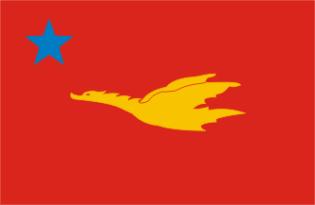
New Mon State Party Flag
There are believed to be around 8 million people who claim Mon ancestry and retain their culture and language, but the majority of the Mon (possibly 4 million) use the modern Burmese language for daily business and are literate only in Burmese (not in their native language). The majority of Mon live around the city of Bago or the site of their historic capital, Thaton and the port of Mawlamyaing.
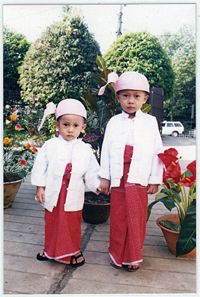
Mon Children (boys)
They also constitute a significant percentage of the population further south along the lowland coast to the city of Ye, Burma.
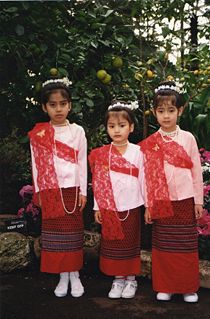
Mon Children (girls)
Early history of Burma_
Humans lived in the region that is now Burma as early as 11,000 years ago, but the first identifiable civilization is that of the Pyu although both Burman and Mon tradition claim that the fabled Suvarnabhumi mentioned in ancient Pali and Sanskrit texts was a Mon kingdom centered on Thaton in present day Mon state.
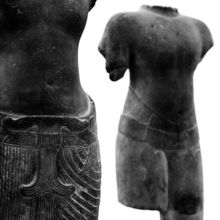 Khmer Arts
Khmer Arts
The Mon were one of the earliest distinct groups to occupy Burma, moving into the area as early as 1500 BCE or possibly earlier. The Mon are primarily associated with the historical kingdoms of Dvaravati and Haripunchai.
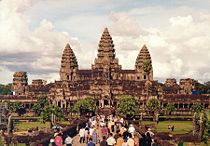
Ankor Wat
Up until the 14th century, outposts of Mon culture continued to spread very Far East, including modern Thailand and Isan plateau cities such as Lampang and Khon Kaen.
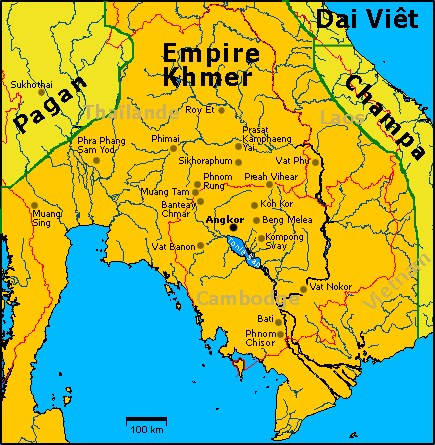
Mon Khmer Empire
Look, Thai’s Upper or North Western region was under Pagan.
Remaining Thai, Laos, Upper Malaysia and Lower Burma
was under Mon-Khmer rule.
As late as the 14th and 15th centuries, it is believed that the Mon were the ethnic majority in this vast region, but also intermarried freely with Khmer and Tai-Kadai populations.
Archaeological remains of Mon settlements have been found south of Vientiane, and may also have extended further to the north-west in the Haripunchai era.The Mon converted to Theravada Buddhism at a very early point in their history.
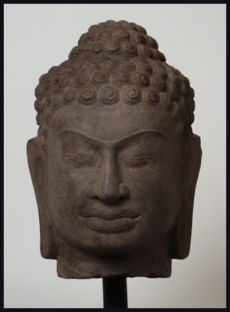 Mon Buddha
Mon Buddha
Unlike other ethnic groups in the region, they seem to have adopted Theravada orthodoxy before coming into contact with Mahayana tendencies, and it is generally believed that the Mon provided the link of transmission whereby both the Thais and Cambodians converted from Hinduism and Mahayana Buddhism to Theravada Buddhism (increasingly from the 1400s).
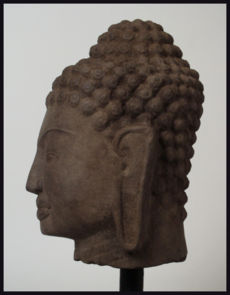 Mon Buddha (side view)
Mon Buddha (side view)
Although the precise date cannot be fixed, it seems that the Mon have been practicing Theravada Buddhism continuously for a longer period than any other extant religious community on earth, except for Sri Lanka, as the lineage was destroyed in India.
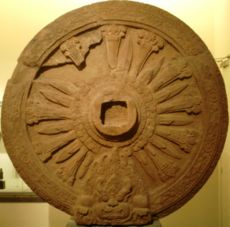
Mon Scripture Wheel
Like the Burmese and the Thais, some modern Mons have tried to identify their ethnicity with the semi-historical kingdom of Suwarnabhumi. Today, this claim is contested by many different ethnicities in South-East Asia, and contradicted by scholars. Historical scholarship indicates that the early usage of the term (as found in the edicts of Ashoka) indicated a location in Southern India, and not in South-East Asia. However, from the time of the first translations of the Ashokan inscriptions in the 19th century, both the Burmese and the Thais have made concentrated efforts to identify place-names found in the edicts with their own territory or culture. Sometimes these claims have also relied upon the creative interpretation of place-names found in Chinese historical sources.
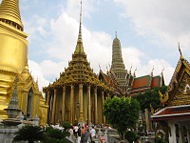 (Mon Khmer) Grand Palace Bangkok
(Mon Khmer) Grand Palace Bangkok
The 6th century Mon kingdom of Dvaravati in the lower Chao Phraya valley in present day Thailand extended its frontiers to the Tenasserim Yoma (mountains). With subjugation by the Khmer Empire from Angkor in the 11th century the Mon shifted further west deeper into present day Burma.
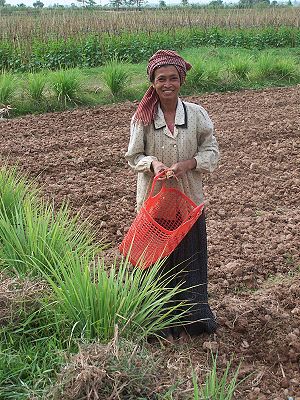 Khmer Women in the field
Khmer Women in the field
Oral tradition suggests that they had contact with Buddhism via seafaring as early as the 3rd century BC and had received an envoy of monks from Ashoka in the 2nd century BC.
The Mons adopted Indian culture together with Theravada Buddhism and are thought to have founded kingdoms in Lower Burma including Thaton in the 6th or 7th century and Bago (Pegu) in 825 with the kingdom of Raman’n’adesa (or Ramanna which is believed to be Thaton) referenced by Arab geographers in 844–8.The lack of archaeological evidence for this may in part be due to the focus of excavation work predominantly being in Upper Burma.
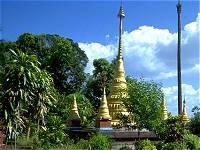
Shampoo Island
The first recorded kingdom that can undisputedly be attributed to the Mon people was Dvaravati, which prospered until around 1000 AD when their capital was sacked by the Khmer Empire and most of the inhabitants fled west to present-day Burma and eventually founded new kingdoms. These, too, eventually came under pressure from new ethnic groups arriving from the north.
Mon kingdoms ruled large sections of Burma from the 9th to the 11th, the 13th to the 16th, and again in the 18th centuries. About the same period, southward-migrating Burmans took over lands in central Myanmar once dominated by Pyu city-states and the Tai started trickling into South-East Asia.
The Burman (Bamar ) established the kingdom of Bagan. In 1057, Bagan defeated the Mon kingdom, capturing the Mon capital of Thaton and carrying off 30,000 Mon captives to Bagan.
After the fall of Bagan to the invading Mongols in 1287, the Mon, under Wareru an ethnic Tai (Shan), regained their independence and captured Martaban and Bago, thus virtually controlling their previously held territory.

Shampoo Island
Mon kingdoms A main body of ethnic Shan / Tai migration came in the 13th century after the fall of the Kingdom of Dali to the Mongol Empire and filled the void left by the fall of the Bagan kingdom in northern Burma forming a loose coalition of city-states. These successive waves of Bamar and Tai groups slowly eroded the Mon kingdoms, and the next 200 years witnessed incessant warfare between the Mon and the Burmese, but the Mon managed to retain their independence until 1539.
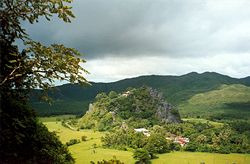
Mon State Mudon
The last independent Mon kingdom fell to the Burmese when Alaungpaya razed Bago in 1757. Many of the Mon were killed, while others fled to Thailand. Hanthawaddy (or Hanthawady; in Thai ??????? Hongsawadi) is a place in Burma. Hongsawatoi ( Bago/Pegu/ Handawaddy ) Hongsawatoi, Capital city of old Mon kingdom.
It was destroyed by Burman King, U Aungzeya or Aloungpaya in 1757. Hongsawatoi (Mon language pronounce) (Pali Hamsavati) Bago is about 50 miles from Rangoon.

Shampoo Island
According to legend, two Mon princess from Thaton founded Bago in 573 AD. It was written in the chronicles that eight years after enlightenment, Lord Buddha along with his disciples went air-borne around Southeast Asian countries.
The earliest mention of this city in history is by the Arab geographer Ibn Khudadhbin around 850 AD. At the time, the Mon capital had shifted to Thaton. The word Mranma, in both Mon and Myanmar inscriptions came into being only at about the same time, lending support to this claim that the Pyu were an earlier vanguard of southward Tibeto-Burman migration who were entirely absorbed into a newly formed identity by later waves of similar people.
The Pagan Kingdom grew in relative isolation until the reign of Anawrahta (1044-77) who successfully unified all of Burma by defeating the Mon city of Thaton in 1057. The area came under rule of the Burmese from Bagan in 1056.
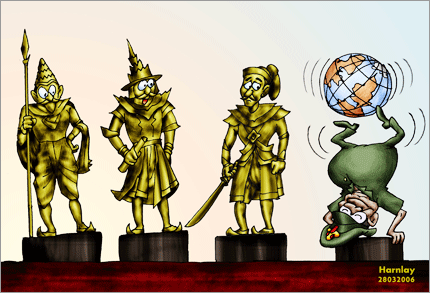
Kyansittha, Alaungphaya, Bayintnaung and Nga Paw
Consolidation was accomplished under his successors Kyanzittha (1084–1112) and Alaungsithu (1112-67), so that by the mid-12th century, most of continental Southeast Asia was under the control of either the Pagan Kingdom or the Khmer Empire. The Pagan kingdom went into decline as the Mongols threatened from the north. The last true ruler of Pagan, Narathihapate (1254-87) felt confident in his ability to resist the Mongols and advanced into Yunnan in 1277 to make war upon them. He was thoroughly crushed at the Battle of Ngasaunggyan, and Pagan resistance virtually collapsed. The king was assassinated by his own son in 1287, precipitating a Mongol invasion in the Battle of Pagan.
The Mongols successfully captured most of the empire, including its capital, and ended the dynasty in 1289 when they installed a puppet ruler in Burma.
After the collapse of Bagan to the Mongols in 1287, the Mon regained their independence. From 1369-1539, Hanthawaddy was the capital of the Mon Kingdom of Ramanadesa, which covered all of what is now lower Burma.
The area came under Burman control again in 1539, when it was annexed by King Tabinshweti to his Kingdom of Taungoo.
The kings of Taungoo made Bago their royal capital from 1539-1599 and again in 1613-1634, and used it as a base for repeated invasions of Siam. A Mon dynasty ruled Lower Burma after the fall of the Pagan dynasty from 1287 to 1539 with a brief revival during 1550–53. At first Martaban was the capital of this kingdom and then Pegu.
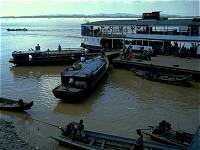
Mawlamying jetty
The Mon king Rajadhirat, who waged war with the northern Burman kingdom of Ava during the whole duration of his reign, unified and consolidated the Mon kingdom’s domains in Lower Burma.The most famous Mon monarchs during this period were Queen Baña Thau (Burmese: Shin Sawbu; reigned 1453–1472) followed by Dhammazedi (reigned 1472–92). Queen Baña Thau personally chose Dhammazedi to succeed her. Dhammazedi had been a monk before he became king of Pegu. Under Dhammazedi, Pegu became a centre of commerce and Theravadan Buddhism. These two devout Buddhist monarchs initiated a long period of peace in Lower Burma.Many foreign traders were attracted to the capital, which became well-known to the outside world as a centre of commerce. As such it is mentioned by the Russian merchant, Nitikin, who traveled in the East about 1470.
Its fifteenth century rulers were, like those of old Pagan, chiefly interested in the development of religion. Missions were sent to Ceylon and on their return stimulated an important religious revival, which affected the whole of Burma.
Its centre was the Kalyani thein near Pegu, so named because its original monks had been ordained on the banks of the Kalyani River in Ceylon. Kalyani ordination became the standard form for the whole country. The story of the reforms is told in the Kalyani inscriptions erected by King Dammazedi (1472-92). Dammazedi was the greatest of the rulers of Wareru’s line. His reign was a time of peace and he himself was a mild ruler, famous for his wisdom. A collection of his rulings, the Dammazedi pyatton, is still extant. He maintained friendly intercourse with Yunnan and revived the practice of sending missions to Buddhagaya. He was a Buddhist ruler of the best type, deeply solicitous for the purification of religion. Under him civilization flourished, and the condition of the Mon country stands out in sharp contrast with the disorder and savagery which characterized the Ava kingdom. When he died he was honoured as a saint and a pagoda was erected over his bones.
The Mon kingdom possessed two great pagodas of especial sanctity, the Shwemawdaw at Pegu and the Shwe Dagon at the small stockaded fishing-town of Dagon, now Rangoon, the capital of modern Burma.
 Shwe Dagon
Shwe Dagon
The last Mon kingdom was Hongsavatoi—they re-conquered much of their lost territory until the energetic Burman leader U Aungzeya forced them back and captured the kingdom by 1757, massacring a considerable part of the population. The Mon religious leaders were forced to flee to Siam and the Mon have been harshly repressed from the 1750s to the present day.

Shwe Maw Daw (Pegu)
King Mingyinyo founded the First Toungoo Dynasty (1486–1599) at Toungoo, south of Ava, towards the end of the Ava dynasty. After the conquest of Ava by the Shan invaders in 1527 many Burmans migrated to Toungoo which became a new center for Burmese rule. The dynasty conquered the Mohnyin Shan peoples in northern Burma. By this time, the geopolitical situation in Southeast Asia had changed dramatically. Mingyinyo’s son king Tabinshwehti (1531-50) unified most of Burma. The Shan gained power in a new kingdom in the North, Ayutthaya (Siam), while the Portuguese had arrived in the south and conquered Malacca. With the coming of European traders, Burma was once again an important trading centre, and Tabinshwehti moved his capital to Pegu due to its strategic position for commerce. Tabinshwehti was able to gain control of Lower Burma up to Prome, but the campaigns he led to the Arakan, Ayutthaya, and Ava in Upper Burma were unsuccessful. When Tabinshwehti’s brother-in-law, Bayinnaung (1551-81), Tabinshwehti’s brother-in-law, succeeded to the throne he launched a campaign of conquest invading several states, including Manipur (1560) and Ayutthaya (1569). An energetic leader and effective military commander, he made Toungoo the most powerful state in Southeast Asia, and extended his borders from Laos to Ayutthaya, near Bangkok. His wars stretched Myanmar to the limits of its resources, however, and both Manipur and Ayutthaya, which had remained under Myanmar domination for 15 years, were soon independent once again. Bayinnaung was poised to deliver a final, decisive assault on the kingdom of Arakan when he died in 1581. Faced with rebellion by several cities and renewed Portuguese incursions, the Toungoo rulers withdrew from southern Burma and founded a second dynasty at Ava, the Restored Toungoo Dynasty (1597–1752). Bayinnaung’s grandson, Anaukpetlun, once again reunited Burma in 1613 and decisively defeated Portuguese attempts to take over Burma. Encouraged by the French in India, Pegu finally rebelled against Ava, further weakening the state, which fell in 1752.
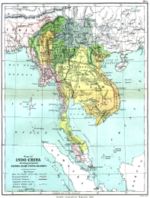 Mon Shan dominence
Mon Shan dominence
Indo China
Filed under: Alaungsithu, Anawrahta, Burmese, Burmese Kings, Cambodia, Colony, Democratic activists, English Article, Ethnic Minorities, Game Plan, History, Khmer, Kyanzittha, Mon Khmers, Mongol invasions, Mons, Myanmar, Myanmar History, Myanmar Military, Politics, Pyu, Religion, SPDC, SPDC Generals, Shan, Thailand, Vietnam, culture | Tagged: Anawrahta, Blogging, Burma, Burmese History, Colony, History, Mon, National day, Shan, South East Asia



0 comments:
Post a Comment